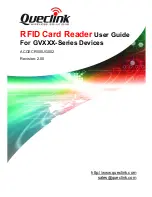
5. Operating the INFINITE M1000 PRO
2011-09
Instructions for Use for INFINITE M1000 PRO No. 30064852 Rev. No. 1.0
61
Flash Settings
On the fly measurements with 1 flash per well are possible for all plate types.
However, measurement precision at low light levels depends on the length of the
reading time during which a fluorescence signal can be received. For prompt
fluorescence, it does not help to increase the default integration time, because
the detector will not receive more signal once the flash has vanished.
Note
Increase the number of flashes per well until noise of BLANK wells does
not improve further, or until the measurement time per well becomes
unacceptable.
Flash Frequency Mode
The
INFINITE M1000 PRO
allows switching between two flash frequencies for
the Fluorescence Intensity and Fluorescence Intensity Scan mode: 100 and
400 Hz (100/400 flashes per second). As a standard, it is recommended to use
the 400 Hz mode and 50 flashes. A higher number of flashes, and therefore a
higher number of single measurement values, results in more accurate final
measurement values.
For time resolved fluorescence (TRF) measurements we recommend using the
100 Hz mode to improve results.
Timing Parameters for Time Resolved Fluorescence
For TRF, signal integration parameters need to be adjusted according to the
label. The start of the signal Integration Time is delayed by the Lag Time of the
preceding flash. TRF timing parameters may be established with the following
procedure:
1)
As a starting point, take, for example, the
Fluorescence Lifetime
of the
label for both
Integration Time
and
Lag Time
.
2)
Coarse tuning: With the Integration Time fixed, reduce the Lag Time to
maximize
Signal to Background (S/B)
.
3)
Fine tuning: With the Lag Time fixed, extend the Integration Time and
check if S/B improves further.
4)
Optional Fine-tuning: With one timing parameter fixed, vary the other one
and check if S/B improves further.
A comparison of S/B with different timing parameters is valid if gain is fixed. For
dual TRF labels, establish the procedure for the label with the shorter
fluorescence lifetime (label 1). Compromise the Integration Time of label 1 with
the Lag Time of label 2.
















































